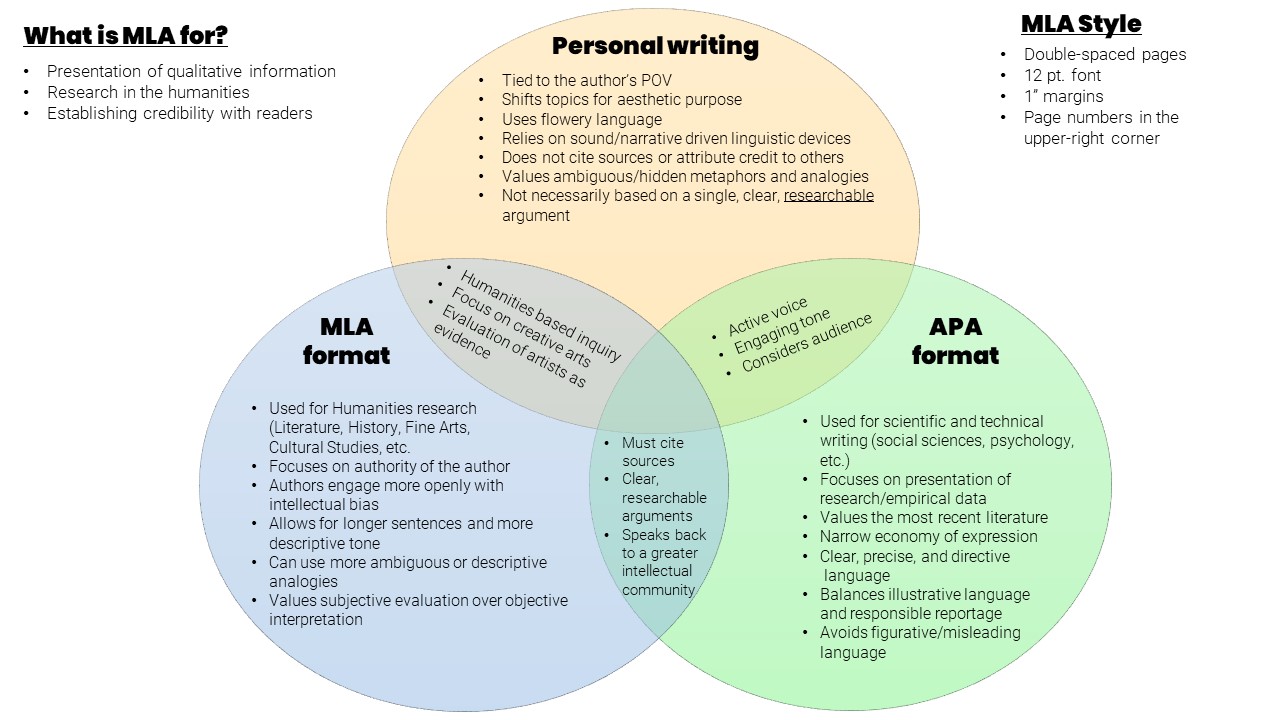MLA citations
A guide to formatting in MLA style
The information below is drawn from the Modern Language Association Handbook, 9th edition. In order to find a more in-depth explanation of any item below, be sure to buy a copy for yourself or check one out from VCU Libraries.
Formatting and Styling Guidelines
Select a header below to learn more about writing in MLA.
- Font options: Regardless of font, use 12pt size
- 1-inch margins
- Header with your last name and page number for all pages in the upper right-hand corner, 0.5 inch from the top, flush to the right
- Double-spaced
- Used for Humanities research (Literature, History, Fine Arts, Cultural Studies. etc.) because it focuses on “enabling readers to participate fully in conversations between writers and their sources” (Fitzpatrick xii).
- Descriptive tone encourages longer sentences Can use more ambiguous or descriptive analogies
- Values subjective evaluation over objective interpretation
- No title page unless specifically requested!
- In upper left-hand corner of first page, include: name, instructor’s name course name and number, date
- Center the title
Short (Prose: 4 typed lines or fewer; Verse: 3 lines)
- Enclose the quotation within double quotation marks. Include in-text citation and a complete reference on the Works Cited page
- Punctuation marks should appear after the parenthetical citation
Long (Prose: more than 4 lines; Verse: more than 3 lines)
- Start the quotation on a new line, with the entire quote indented 1/2 inch
- Place quotations in a free-standing block of text
- When citing long sections of poetry keep formatting as close to the original as possible.
- When citing two or more paragraphs, use block quotation format.
- Parenthetical citation should come after the closing punctuation mark.
- When quoting verse, maintain original line breaks
MLA format use the author-page model (Author page #).
- If a source does not have page numbers, the citation can include line, paragraph, or chapter numbers instead. For electronic or internet sources that do not have page numbers, the in-text citation only requires the author.
When citing sources with three or more authors, list only the last name of the first author and et al. (Author et al. page #).
The first time you mention a source in your paper, you must include a signal phrase. A signal phrase includes a verb as well as the name of the author who wrote your source. If you do not know the name of the author, use the name of the organization that published the work you are citing.
Example 1: According to Kristine Johnson, there is a connection between writing and emotion (59-60).
Example 2: Michelle Navarre Cleary proposes ten reasons why students plagiarize (66-71).
Beware the citation generator!
- We all know technology isn't perfect, so it's best to avoid relying on a citation generator for your Works Cited entries. Furthermore, many citation generators are not up to date with the latest MLA style
- Moral of the story? Don't lose precious points to a technology fail!
Works Cited entries should include the following:
- Author's name
- Title(s)
- Editor(s), translator(s), illustrator(s), performer(s), and other contributors
- Volume, version, or edition
- Issue or number
- Publisher
- Publication date
- Location or page number(s) and DOI
- Access date (for sources accessed online)
Scholarly articles
- Last name, First name. "Article Title." Journal Title in Italics and Title Case, volume, issue number, date of publication, location including page number(s) and DOI, if available. URL if accessed online and no DOI is available. Access date if accessed online.
Work with three or more authors
- Last name, First name, et. al. Book Title in Italics and Title Case, Publisher, year of publication.
Web page, author and date unknown
- Format: "Title of Web Page in Title Case."Website Title in Italics, URL. Access date.
- Choose language that is specific and sensitive to labels.
- Be inclusive and people-first. Don’t show judgment, even indirectly.
- Use gender-neutral language, only using gendered language when necessary
- MLA endorses the singular “they” to promote inclusive language
- When possible, use your participants’ names
- Avoid heteronormativity
- Use the most up-to-date language that is generally preferred by the group you are referring to
- Only specify race if it is relevant to the study
- Vary the placement of socially dominant groups in lists
- Avoid stereotypes
Scholarly articles
Last name, First name. "Article Title." Journal Title in Italics and Title Case, volume, issue number, date of publication, location including page number(s) and DOI, if available. URL if accessed online and no DOI is available. Access date if accessed online.
Cohen, Michael. "Is Kermit the Frog in Trouble?" American Journal of Medical Genetics, vol. 104, no. 2, 2001, pp. 99-100, doi: 10.1002/ajmg.10001. Accessed 7 May 2019.
Work with three or more authors
Last name, First name, et. al. Book Title in Italics and Title Case, Publisher, year of publication.
Ambrose, Susan A., et. al. How Learning Works: Seven Research-Based Principals for Smart Teaching. Jossey-Bass, 2010.
Web page, author and date unknown
"Title of Web Page in Title Case."Website Title in Italics, URL. Access date.
"Kermit the Frog Puppet."Smithsonian National Museum of American History, https://americanhistory.si.edu/collections/search/object/nmah_765593. Accessed 7 May 2019.
Need more examples?
Check out the online Purdue OWL guide for a comprehensive list of MLA Works Cited and in-text citation examples.
